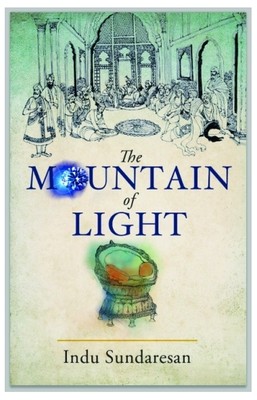He who owns this diamond will own the world, but will also know all
its misfortunes. Only God, or a woman, can wear it with impunity.
The diamond in question is of great historical importance, and the title of the book is a translation of the name bestowed upon the world’s most famous diamond: Kohinoor. In this fantastically dazzling light, author Indu Sundaresan has glorified the stone’s journey as it gets relayed among owners and rulers in Persia, Afghanistan and India, before shining bright among the jewels in England (where it could still be found). History plays a major role in this fiction, and there’s a detailed and rewarding account of how East India Company and British Raj changed the entire course of the country by depriving of its wealth.

The Kohinoor account, spanning almost a hundred years, features many a real historical characters and events, having webbed them into a beautiful world of fiction. The many characters bring in their many perspectives, and it’s a real pleasure to uncover the real emotion that drives a particular character at a given point of time. My favorite segment from this book is also the most tear-jerked one, and revolves around the last heir of the Punhab empire, Dalip singh. Diary of a Maharaja ends the book well, and as a reader and as an Indian, you shall feel a deep sense of betrayal lingering around. Maybe that’s the primary motive that drove Indu into writing this fascinating book.
The narrative is linear, and the key-players have been beautifully sketched up. But there are many more characters who’ve been splendidly brought into the story, but they just like smoke away after a while. But that’s understandable, since there are so many characters thrown in, it’s difficult to celebrate each one’s individuality in some 300-odd pages. And also, the 186-carat jewel is the main hero of the book, so brief character sketch-ups were ok. The background imagery rekindles the lost era of 1900s (and earlier), and deep research spines up this beautiful fiction that I’ll remember for a long time to come. And yes, whatay sharp contrast between the British and Indian cultures! Nice.This was my very first Indu Sundaresan, and I’m planning to read more of her pretty soon. Perhaps I shall pick up the Taj Trilogy to read and review.
Overall Rating: 3.5/5
About the author-Indu Sundaresan was born in India and grew up on Air Force bases all over the country. Her father, a fighter pilot, was also a storyteller—managing to keep his audiences captive and rapt with his flair for drama and timing. He got this from his father, Indu’s grandfather, whose visits were always eagerly awaited. Indu’s love of stories comes from both of them, from hearing their stories based on imagination and rich Hindu mythology, and from her father’s writings.
After an undergraduate degree in economics from India, Indu came to the U.S. for graduate school at the University of Delaware. But all too soon, the storytelling gene beckoned.
You may buy The Mountain of Light from Flipkart here: 
The diamond in question is of great historical importance, and the title of the book is a translation of the name bestowed upon the world’s most famous diamond: Kohinoor. In this fantastically dazzling light, author Indu Sundaresan has glorified the stone’s journey as it gets relayed among owners and rulers in Persia, Afghanistan and India, before shining bright among the jewels in England (where it could still be found). History plays a major role in this fiction, and there’s a detailed and rewarding account of how East India Company and British Raj changed the entire course of the country by depriving of its wealth.
The Kohinoor account, spanning almost a hundred years, features many a real historical characters and events, having webbed them into a beautiful world of fiction. The many characters bring in their many perspectives, and it’s a real pleasure to uncover the real emotion that drives a particular character at a given point of time. My favorite segment from this book is also the most tear-jerked one, and revolves around the last heir of the Punhab empire, Dalip singh. Diary of a Maharaja ends the book well, and as a reader and as an Indian, you shall feel a deep sense of betrayal lingering around. Maybe that’s the primary motive that drove Indu into writing this fascinating book.
The narrative is linear, and the key-players have been beautifully sketched up. But there are many more characters who’ve been splendidly brought into the story, but they just like smoke away after a while. But that’s understandable, since there are so many characters thrown in, it’s difficult to celebrate each one’s individuality in some 300-odd pages. And also, the 186-carat jewel is the main hero of the book, so brief character sketch-ups were ok. The background imagery rekindles the lost era of 1900s (and earlier), and deep research spines up this beautiful fiction that I’ll remember for a long time to come. And yes, whatay sharp contrast between the British and Indian cultures! Nice.This was my very first Indu Sundaresan, and I’m planning to read more of her pretty soon. Perhaps I shall pick up the Taj Trilogy to read and review.
Overall Rating: 3.5/5
About the author-Indu Sundaresan was born in India and grew up on Air Force bases all over the country. Her father, a fighter pilot, was also a storyteller—managing to keep his audiences captive and rapt with his flair for drama and timing. He got this from his father, Indu’s grandfather, whose visits were always eagerly awaited. Indu’s love of stories comes from both of them, from hearing their stories based on imagination and rich Hindu mythology, and from her father’s writings.
After an undergraduate degree in economics from India, Indu came to the U.S. for graduate school at the University of Delaware. But all too soon, the storytelling gene beckoned.
You may buy The Mountain of Light from Flipkart here: